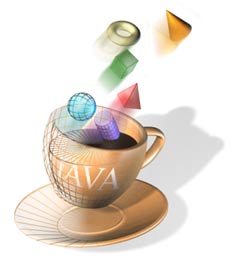
FB 4
Internationale Media and Computing
MeSoII: Media Software II
Sommersemester 2003

|
FB 4 |
Catch up with Star Wars – beam your Data.
The last two exercises are all about programming mobile phones and handhelds. This is a complex technology requiring both a clear understanding of the overall concept and device specific details, and a lot of endurance (plus good humor) for setting up the development environment. But if you get a full understanding and only just a tiny bit working, it is still worth the investment, because it's a fast growing application area…
You have the choice of two different paths:
Path I – SuperWaba:
Learn about Waba and SuperWaba – an open source project offering an SDK for programming small devices plus – of course – VMs for different small devices, targeting handhelds in particular. SuperWaba allows you to develop programs for your Palm etc. on your normal computer. You have to log in to the musical teaching environment to read the tutorials. Spend two exercises doing one or two of the three tutorials offered. The exercise is available through the Learning Management System of the FHTW, CLIX-Campus. The tutorials are purchased and may not be distributed. The link to CLIX-Campus can be found by going to http://musical.fhtw-berlin.de/ and following the link "Zugang zur Lernplattform". Each of you has an account (s0123456 or whatever your student number is) and a password. The passwords are available from your teacher.
Before starting to write programs or experiment, answer the following questions:
- What is the content of the SuperWabaSDK? (explain the directory structure)
- What consequences does the smallness of the devices have?
- What are Warp and Exegen doing, what is a .prc and a .pdb file?
- Why do you need a "normal" Java SDKas well as the SuperWabaSDK?
- What has to be installed on the handheld and how in order to run a SuperWaba application?
- How can I test my application?
(all these questions can ba answered from the indispensable http://www.superwaba.com.br/etc/SuperWaba.pdf )
Even if you are planning to use Tauschke's mobileCreator IDE, try to set up JBuilder for SuperWaba development, so that you really understand the difference from other APIs.
Path II – Sun's J2ME
Get to know Sun's J2ME API (i.e. Java 2 Micro Edition) for programming limited and wireless devices. This API enables you to build applications that run on small devices like mobiles or handhelds. Different from SuperWaba, the emphasis is on connectedness, i.e. the applications normally are to be downloaded from a server and run an your mobile or handheld, much like Applets; but once installed, they reside on the device and can be used without connection. Just like SuperWaba, you develop your application on your normal computer and then deploy it to a server from where your mobile can download an run it, - if you have Sun's KVM installed on it. DON'T PANIC – nobody is going to interfere with your personal mobile phone, we will be using emulators instead…
To start with, you'll be following Sun's MIDP leraning path http://wireless.java.sun.com/learn/midp/getstart/ to learn about the basic concepts and future perspectives and begin writing your own MIDP-application.
1. Read the introduction and make up your
own glossary. Spend some time studying the Concept Map. So, what do you need to
install in order to develop an application for your (future) mobile, and where
do you get it from? Can you download software for writing PDA applications? And
what is KVM? What do CLDC and MIDP mean? etc…(Put all your answers in your
report.)
2. Also read the user's guide provided with the wtk to understand
the overall setup: <J2meWTK20>\docs\UserGuide_HTML\index.html
3. (You
may have to install the WTK yourself, because it requires write permission on
its installation directory)
4. Do tutorial I, using the WTK – as far
as you get.
5. Now, let's use a more sophisticated IDE
– JBuilderMobileSet. It is just an extension to your Standard JBuilder, so
you should be used to the handling. Follow the instructions in the Developer's
Guide for settng up a project: http://ftp.vit.edu.tw/pc2/borland/jbuilder/techpubs/jbuilder7/mobilesetdocs.pdf
6. Look through chapters 5, 6, and 10, and then embark on the tutorial in Appndix
A.
7. If things went really well, do the next tutorial, too.
All exercise reports are due at 8.00 am on 2003-07-16.
I would like for you to include in this final exercise report an assessment of what you personally learned from this course:
Have a great summer!